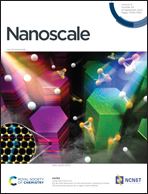Remarkably high thermal-driven MoS2 grain boundary migration mobility and its implications on defect healing†
Abstract
Two-dimensional (2D) transition-metal dichalcogenides (TMDs) hold great potential for many important device applications, such as field effect transistors and sensors, which require a robust control of defect type, density, and distribution. However, how to control the defect type, density, and distribution in these materials is still a challenge. In this study, we explore the kinetics and dynamics of four types of grain boundaries (GBs) in monolayer MoS2, which are composed of S-polar dislocation (S5|7), Mo-polar dislocation (Mo5|7), dislocation-double S vacancy complex (S4|6), and dislocation-double S interstitial complex (S6|8), respectively. Our study shows that these four GBs in monolayer MoS2 exhibit a great disparity in their migration behavior. More specifically, the S4|6 and S6|8 GBs possess a much higher migration mobility than the S5|7 and Mo5|7 GBs under the same thermal fluctuations or temperature gradient. Interestingly, the S4|6 and S6|8 GBs follow an abnormal relationship with temperature, due to the change in defect configurations with temperature. Our study further shows that the remarkably high mobilities of the S4|6 and Mo6|8 GBs may enable the reactions of GBs, leading to the annihilation and reduction of defect density. In addition, the movement of GBs in MoS2 under a temperature gradient field can cause defect redistribution, which in turn changes the thermal conductivity. The present study not only deepens our understanding of the dynamic evolution of GBs in TMDs, but also presents new opportunities to engineer GBs for novel electronic applications.



 Please wait while we load your content...
Please wait while we load your content...